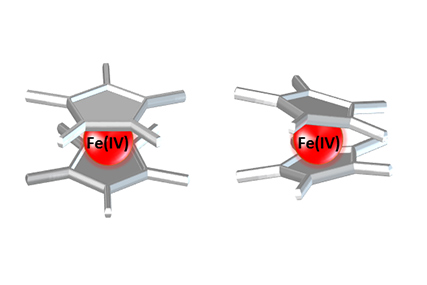Synthetic-chemical milestone: new ferrocenium molecule discovered
Researchers at FAU working together with colleagues from Freie Universität Berlin have discovered a new molecule: the iron compound in the rare oxidation state +4 belongs to the ferrocenes and is exceptionally difficult to synthesise.
Metallocenes are also known as sandwich compounds. They consist of two organic, ring-shaped compounds, the cyclopentadienyl ligands, which are arranged parallel to each other, surrounding a central metal ion – just like two slices of bread in a sandwich. Since the discovery of this class of compounds in the 1950s, which began with the neutrally-charged parent compound ferrocene, followed by oxidised ferrocenium, there has been strong international research interest in these molecules. This arises from fundamental interest in their bonding characteristics, but also from the variety of modern application possibilities of the class of compounds in fields such as electrochemistry and tumour treatment and as polymerisation catalysts.
The iron compounds were previously only known in the oxidation states +2 and +3, which refer to the ionic charge of an atom. A team of researchers from Freie Universität Berlin and FAU have succeeded in synthesising, isolating and studying an iron compound in the rare oxidation state +4 for the first time. The molecule [Cp*2Fe]2+ was the result. ‘This is a milestone in synthetic chemistry,’ says Prof. Dr. Karsten Meyer from FAU’s Chair of Inorganic and General Chemistry. ‘The new molecule will surely have a place in modern chemistry textbooks. Its synthesis creates valuable knowledge and will make teaching even more interesting.’
The new molecule is extremely sensitive and reactive. Its synthesis and analysis require special measures to be taken. The fluorine specialists from Berlin had to oxidise ferrocene with a xenon-fluorine compound in liquid hydrogen fluoride – a colourless, poisonous gas with a strong odour. The researchers confirmed the success of the synthesis by analysing the structures of a series of different salts. The FAU chemists created special highly resistant sample containers to analyse the molecule. The containers prevent the decay of the samples and damage to the sensitive analysis equipment. This revealed a special property of the new molecule in oxidation state +4: in contrast to other ferrocenes, it forms different structures – either linear or angled – depending on whether anions are used to stabilise the molecule. These structural differences are caused by supramolecular interactions between the ions. The FAU chemists Mario Adelhardt and Jörg Sutter were able to explain the unusual electronic structures of this ‘exotic’ compound.
The researchers published their findings in the journal Science. DOI: http://dx.doi.org/10.1126/science.aaf6362
Further information:
Prof. Dr. Karsten Meyer
Phone: +49 9131 8527360
karsten.meyer@fau.de
